- | Regulation Regulation
- | State Testimonies State Testimonies
- |
Wisconsin Occupational Licensing: Easing the Burden for Service Members, Former Service Members, and Military Spouses
Testimony before the Wisconsin State Legislature, Senate Committee on Public Benefits, Licensing, and State-Federal Relations
Chair Kapenga, Vice Chair Craig, and distinguished members of the committee:
My name is Matthew Mitchell. I am an economist and a senior research fellow at the Mercatus Center at George Mason University, where I direct the Equity Initiative. In November I spoke with you about the economic literature regarding licensure. Among other things, I spoke of the evidence that most forms of licensure do not seem to increase consumer safety or quality while licensure does increase consumer prices and create barriers to entry for certain populations.
I am grateful for the opportunity to speak with you again. Today, I will focus specifically on the evidence that licensure can be a substantial barrier to employment, particularly for certain populations such as lower-income Americans or the spouses of active-duty military personnel.
Licensing Represents a Significant and Growing Barrier to Work
Nationally, the share of the workforce that is required to have an occupational license has increased more than fourfold in the past 50 years. As of 2015, nearly one in five working Wisconsinites—about 18 percent of the state’s workforce—was required to be licensed.[2]
As licensing burdens have increased nationwide, they seem to have depressed interstate migration of those in licensed professions. Economists Janna Johnson and Morris Kleiner estimate that between-state migration of those who are licensed is 36 percent lower than that of members of other professions.
Licensing Is Economically Costly
In separate research, Kleiner and Evgeny Vorotnikov estimate that licensure may cost between 1.8 and 1.9 million jobs, result in between $6.2 billion and $7.1 billion in lost output, and create a misallocation of resources that costs the US economy between $183.9 billion and $197.3 billion each year. In Wisconsin alone, they estimate that licensure has eliminated more than 37,000 jobs, has resulted in $133 million in lost annual output, and has created a $3.7 billion annual misallocation of resources.
Aspiring entrants to a large number of professions—ranging from travel guide and taxidermist to cosmetologist—are now required by the state of Wisconsin to obtain a government-issued license to work. It can take months and hundreds or even thousands of dollars to obtain these licenses. Among 42 low- to moderate-income occupations licensed by Wisconsin, the average aspiring worker is required to spend 214 days in training and pay $259 in fees before he or she may obtain a license. These fees do not include either the cost of the education or the income that people forgo when they spend months in often-unnecessary training. According to the Institute for Justice, Wisconsin’s licensing laws are the 36th most broad and onerous in the country.
Licensure Is Often Arbitrary
As shown in table 1, licensing requirements often don’t match the risk posed to the public by insufficiently trained professionals in certain industries. Compared with emergency medical technicians, aspiring cosmetologists in Wisconsin must undergo 10 times as many months of training; would-be sign language interpreters (who are unlicensed in 29 states) must complete more than 40 times as much training; and veterinary technicians (unlicensed in 15 states) must complete more than 20 times as much training.
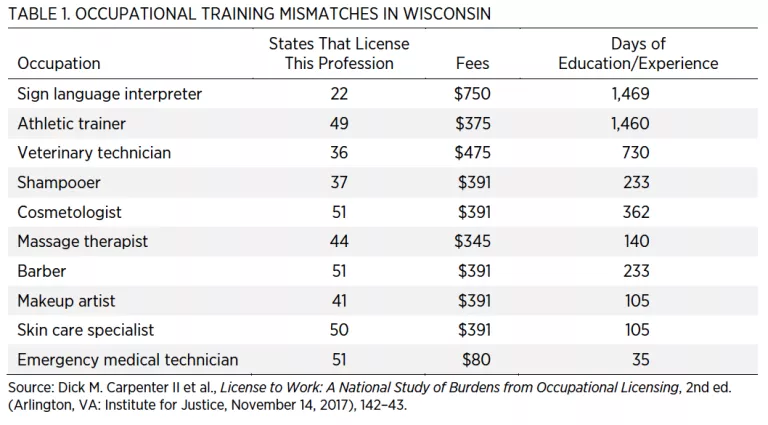
Licensing Boards Are Often Dominated by Members of the Professions They Oversee
Ninety-three percent of Wisconsin occupational licensure boards are required by law to have a majority of their members work in the professions they oversee. See table 2 for board composition data in a sample of Wisconsin boards. Owing to vacancies or a lack of specificity, some boards may be composed entirely of industry insiders, while on other boards industry insiders have a governing majority. This presents a legal concern in light of the US Supreme Court’s decision in North Carolina State Board of Dental Examiners v. FTC, which held that states may be liable for antitrust violations when boards are dominated by members of the professions they oversee and when elected officials fail to actively supervise these boards. It also creates a practical concern that boards will tend to act as industry cartels, controlling entry of new members rather than ensuring public safety.
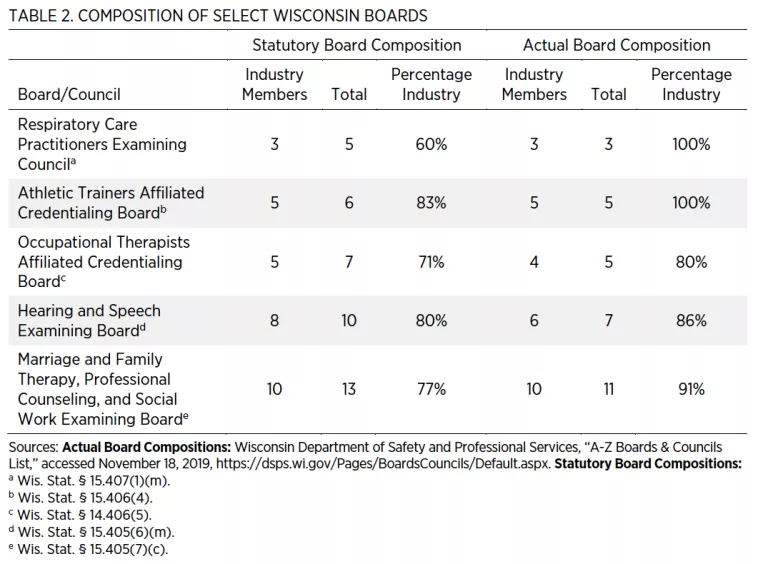
Licensing Reduces Employment Opportunities, Especially among Certain Communities
High barriers to employment pose particular difficulties to lower-skilled, lower-educated populations, to immigrants, to those with criminal records, and to those who move frequently, such as military spouses. As shown in figure 1, 80 percent of the studies Mercatus scholars reviewed found that licensure has a disparate impact on minorities.
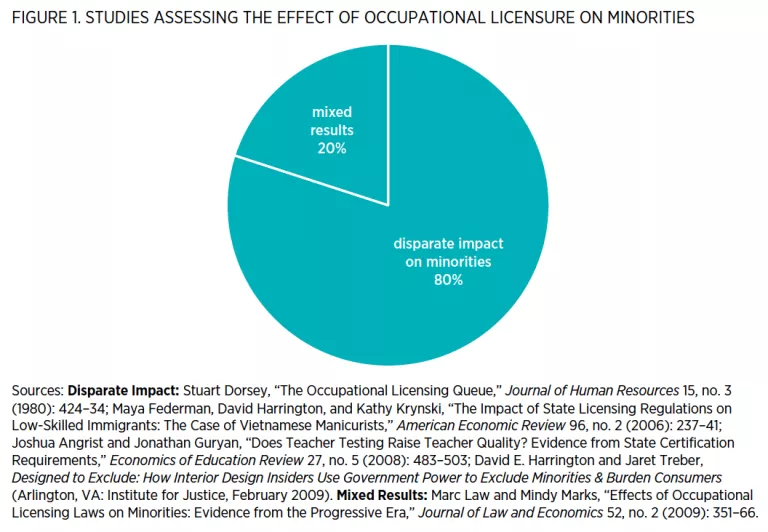
Recent research finds that in countries with more barriers to entering business, measured income inequality is greater. Separate research finds that in states with greater growth in licensure for low- to moderate-income occupations, there is less absolute income mobility, as measured by the chances that an individual raised in a relatively low-income household will move up the income distribution.
Those with criminal histories are particularly likely to be stymied by these laws. The Council of State Governments Justice Center estimates that nationally about 15,000 laws and regulations limit the ability of those with prior convictions to obtain state occupational licenses. Among these, 6,000 are blanket or mandatory restrictions.
Licensure presents an especially steep employment barrier for military spouses. About 35 percent of working military spouses are either licensed or certified. And compared with the broader population, military spouses are 10 times more likely to have moved across a state line in the past year. When military spouses were asked to name the biggest challenges to employment, 22 percent identified the inability to transfer their professional licenses from one state to another. This helps to explain why, in 2017, the military spouse unemployment rate was 16 percent, nearly four times the national average.
Recognition of Out-of-State Licensure for Active Duty and Military Spouses
Because licensure imposes particularly steep burdens for peripatetic military personnel and their spouses, a number of states have moved to ease that burden for this particular population. The most common approach, adopted by every state but Connecticut, is to somehow recognize out-of-state licenses of current or former military personnel, their spouses, or both. This can take a number of forms. In Tennessee, Texas, and Utah, for example, active-duty military personnel and their spouses may work without a license so long as they possess a valid out-of-state license. In the other 46 states that recognize out-of-state licenses, state agencies must grant in-state licenses to those military personnel and their spouses who currently possess valid out-of-state licenses.
In 31 states (shown in figure 2), regulators are required to conduct an expedited review process in order to determine the validity of out-of-state licenses. In 34 states (shown in figure 3), regulators are required to issue temporary licenses during the review period. These temporary licenses can be helpful because they permit recently relocated members of the armed forces or their spouses to get to work right away. However, if a temporary license expires after a short period of time, a worker may be left facing the steep burdens of licensure.
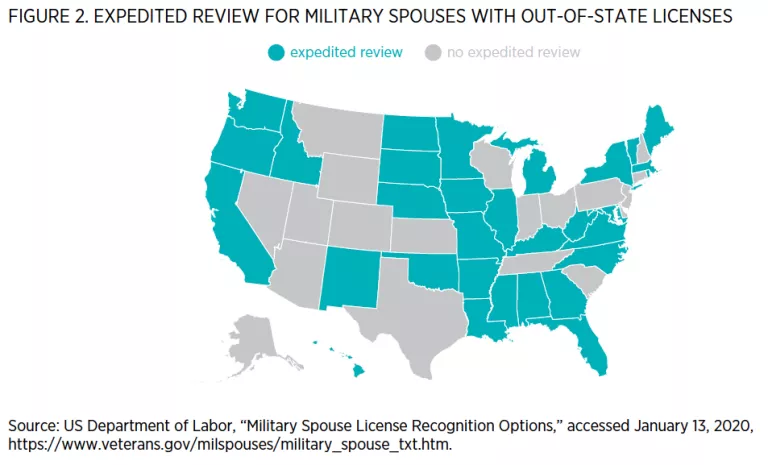
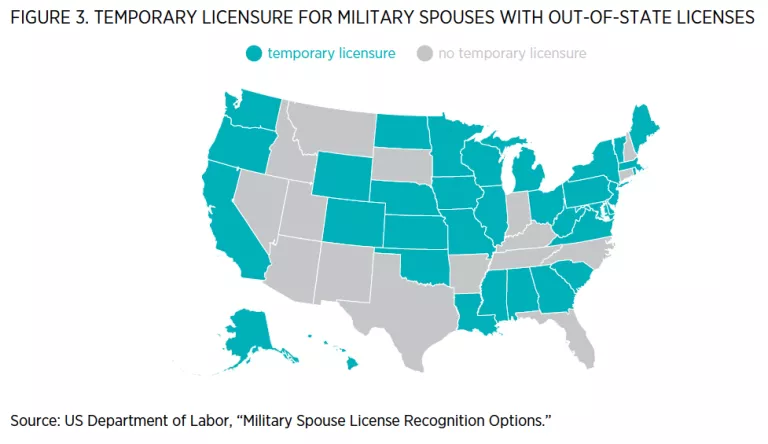
In Wisconsin, current law allows spouses of services members to obtain a reciprocal license to work, but it expires after 180 days. Senate Bill 654 would extend the practice to active duty and former military personnel (“discharged under conditions other than dishonorable within four years of applying for a reciprocal credential”) and would make these licenses valid up until the date at which the out-of-state license would have expired.
While this approach is certainly beneficial for this population, it fails to alleviate the burden borne by most licensed workers.
Policymakers who value consumer protection, lower prices, and greater opportunities for employment—especially among lower-skilled, lower-educated or otherwise disadvantaged populations—would do well to consider broader reforms.
Thank you for the opportunity to share my research with you today. I look forward to answering any questions you may have.

